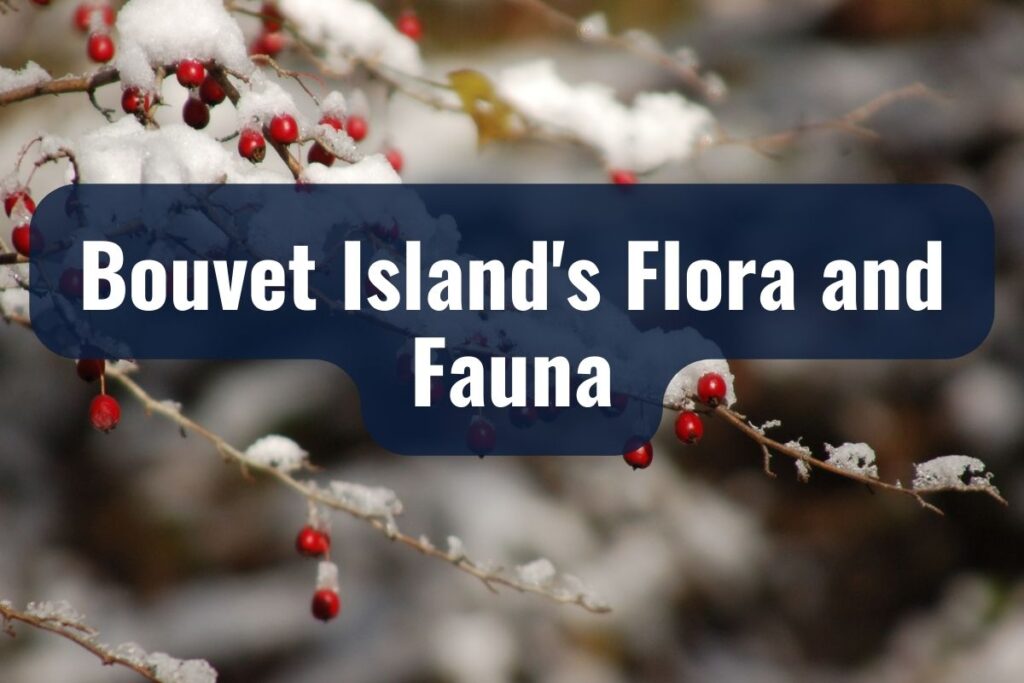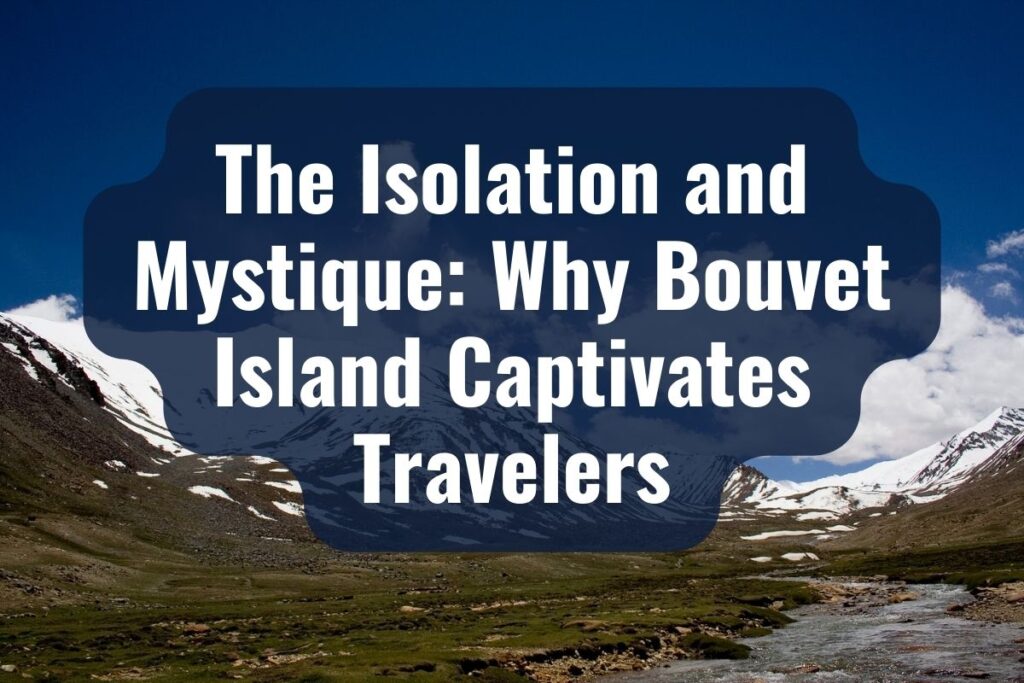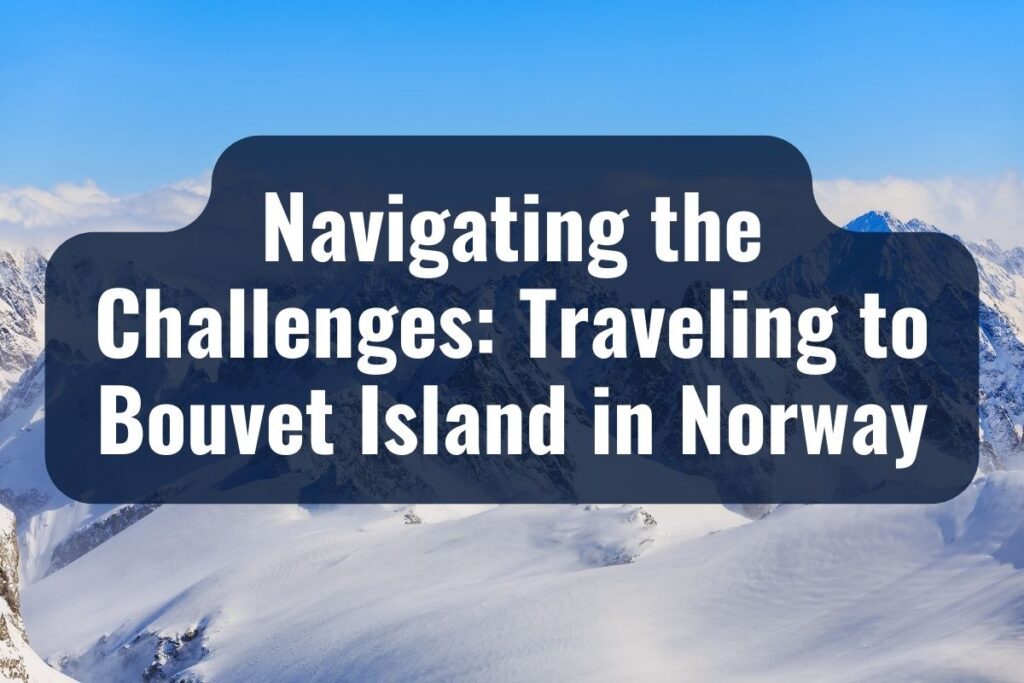Bouvet Island in Norway, an uninhabited volcanic island, emerges as a remote speck in the vastness of the South Atlantic Ocean. This Norwegian territory, one of the most secluded islands on Earth, is shrouded in mystery and intrigue. Its geographical positioning is unique; it sits at approximately 54°26′S 3°24′E, placing it over 1,600 kilometers from the nearest landmass, Antarctica. The island, spanning just 49 square kilometers, is predominantly covered by a glacier, with the ice extending right to the rugged coastline.
The topography of Bouvet Island is as dramatic as it is inhospitable. The center is dominated by an inactive volcano, Olavtoppen, which rises to about 780 meters above sea level, making it the highest point on the island. This peak is often shrouded in thick cloud cover, adding to the island’s enigmatic presence. The rough terrain is interspersed with steep cliffs, deep ravines, and a few rocky beaches that are more accessible.
Key Takeaways
- Bouvet Island is a remote, uninhabited Norwegian territory with a unique and harsh environment.
- Its landscape is shaped by its volcanic origin and covered mostly by glaciers.
- The island has a rich history of exploration and scientific research since its discovery in 1739.
- Despite extreme conditions, it hosts unique wildlife, including penguins and seals.
- Bouvet Island is a critical site for scientific research in climatology and geology.
- The island’s isolation and untouched nature make it a coveted destination for adventurers.
- Cultural references in literature and film have contributed to Bouvet Island’s mystique.
- Traveling to Bouvet Island involves legal permissions, meticulous planning, and preparedness for extreme conditions.
Bouvet Island’s Status as a Norwegian Territory
Norway’s connection to Bouvet Island dates back to the early 20th century. It was in 1927 when Norway laid claim to the island, and the annexation was later solidified in 1930. This move was primarily motivated by the island’s strategic location and potential for scientific research. Despite its remote and harsh environment, Bouvet Island holds a significant place in Norway’s territorial portfolio, symbolizing the nation’s historical ties to polar exploration and scientific study.
The island’s status as a nature reserve, declared in 1971, further underscores Norway’s commitment to preserving this unique part of the world. This designation helps protect the fragile ecosystem of Bouvet Island, ensuring that its environmental and scientific value is recognized and maintained for future generations.
The Geographical Mystique of Bouvet Island

Unveiling the Island’s Landscape
Bouvet Island, a realm of pristine natural beauty, stands as a testament to the raw power of nature. The island’s landscape is predominantly a glacial terrain, with the vast majority of its surface blanketed by an ice cap. This ice cap dramatically transforms the landscape, creating an ever-changing environment that is both awe-inspiring and foreboding.
The island’s rugged topography is marked by sheer cliffs that plunge into the tempestuous waters of the Southern Ocean. These cliffs are often the nesting grounds for various seabird species, adding a touch of life to the otherwise stark landscape. Amidst this icy facade, the island’s volcanic origin is unmistakable. The stark contrast between the black volcanic rock and the white snow creates a striking visual that is both stark and beautiful.
Unique Geological Features
Bouvet Island’s geology is as fascinating as it is unique. The island is essentially the summit of a submerged volcano, part of the Mid-Atlantic Ridge. This volcanic origin contributes to the island’s most prominent geological feature, Olavtoppen. This peak, though dormant, hints at the island’s tumultuous geological past.
Another notable feature is the presence of fumaroles, areas where volcanic gases are released. These fumaroles, although not currently active, indicate that the island is not just a static landscape but a dynamic geological entity. The volcanic soil, combined with the harsh climatic conditions, creates a challenging environment for any form of life and shapes the unique ecological niche Bouvet Island occupies.
Climate and Environmental Conditions
The climate of Bouvet Island is as extreme as its isolation. It is characterized by its polar maritime climate, which brings persistent cold temperatures, high winds, and frequent snowfall. The island experiences long, harsh winters and short, slightly less severe summers. The average temperature hovers around freezing, though it can occasionally rise slightly during the summer months.
This inhospitable climate plays a significant role in shaping the island’s environment. The constant freezing and thawing cycle impacts the glacial movements, contributing to the island’s dynamic landscape. The weather conditions also significantly affect the accessibility of the island, with thick sea ice and treacherous sea conditions often surrounding it, making Bouvet Island a place that is as enigmatic as it is elusive.
A Brief History of Bouvet Island
Early Discovery and Exploration
The story of Bouvet Island begins in the realm of exploration and discovery. It was first sighted in 1739 by Jean-Baptiste Charles Bouvet de Lozier, a French naval officer and explorer, after whom the island was later named. However, Bouvet de Lozier could not land on the island, and its exact location remained uncertain for many years, leading to its reputation as a “phantom island” in early maritime lore.
Subsequent expeditions in the 18th and 19th centuries sought to rediscover and accurately map the island. It was not until 1825 that the island was correctly positioned on global maps, thanks to the efforts of British explorer James Weddell. Yet, even with its location confirmed, the island remained a place of mystery, often bypassed by explorers due to its harsh conditions and inaccessibility.
Norwegian Annexation and Historical Significance
The historical significance of Bouvet Island heightened in the early 20th century. In 1927, Norway’s interest in the island was piqued, largely due to its strategic importance in the Southern Ocean. This led to an expedition led by Harald Horntvedt, which resulted in Norway laying claim to the island in December of the same year. The annexation was formally recognized by international law in 1930, marking the beginning of Norway’s stewardship of the island.
This act of annexation was more than a territorial claim; it was a symbol of Norway’s long-standing tradition and prowess in polar exploration. Bouvet Island became a part of Norway’s polar heritage, representing both the challenges and triumphs of human endeavor in some of the most extreme environments on Earth.
Notable Expeditions and Research Endeavors
Throughout the 20th century, Bouvet Island continued to draw the attention of explorers and scientists. Notable expeditions, both Norwegian and international, embarked on journeys to study the island’s unique environment. These expeditions have focused on a wide range of scientific fields, from geology and glaciology to biology and meteorology.
One of the most significant contributions of these expeditions has been in the field of environmental and climate science. Research conducted on Bouvet Island has provided valuable insights into the dynamics of glacial and volcanic activity, as well as the impact of climate change in polar regions. This research has not only deepened our understanding of the island itself but also of broader environmental processes at work in the Earth’s polar areas.
Bouvet Island’s Flora and Fauna

| Category | Examples | Description |
| Wildlife | Penguins, Seals | Breeding ground for seabirds and marine mammals. |
| Vegetation | Mosses, Lichens | Sparse plant life adapted to harsh climatic conditions. |
| Ecological Balance | Fragile and Interdependent | Sensitive ecosystem, highlighting the adaptability of life in extreme environments. |
Native Wildlife: Seabirds and Marine Life
Despite its harsh and seemingly inhospitable environment, Bouvet Island is home to a surprisingly vibrant array of wildlife, primarily marine birds and mammals. The island serves as an important breeding ground for various seabird species. Among the most notable are the penguins, with the chinstrap and macaroni penguins often seen on the island’s rocky outcrops. These charismatic creatures bring a sense of vitality to the island’s otherwise stark landscape.
Seals are also regular inhabitants, with species like the Antarctic fur seal and the southern elephant seal frequently spotted along the shores. These mammals are drawn to the island’s rich marine ecosystem, which provides ample food resources. The surrounding waters of Bouvet Island are teeming with krill and fish, making it an ideal habitat for these marine predators.
Vegetation: Limited Plant Life due to Harsh Conditions
The flora of Bouvet Island is as unique as it is sparse. The severe climate and the predominantly ice-covered landscape limit plant growth significantly. However, in some of the more sheltered areas and during the brief summer months, a few resilient species of moss and lichen manage to survive. These hardy plants add a subtle hint of green to the predominantly white and grey palette of the island’s scenery.
The presence of these plants, though minimal, is crucial. They play an essential role in the island’s fragile ecosystem, providing a basis for the limited terrestrial food chain and contributing to the soil formation in areas where the ice has retreated.
Discussion of the Ecological Balance and Its Sensitivity
The ecological system of Bouvet Island is a delicate balance, shaped by the extreme climatic conditions and the island’s isolation. This ecosystem is relatively simple, with few species, but each plays a critical role in maintaining the ecological balance. The interdependence of the island’s flora and fauna is a fascinating aspect, illustrating the adaptability of life in extreme environments.
However, this balance is incredibly sensitive to external influences. The isolated nature of the island means that any disturbance, whether from climate change or human activity, could have significant and potentially irreversible impacts. The fragility of Bouvet Island’s ecosystem is a poignant reminder of the need for careful and responsible interaction with our planet’s most remote and vulnerable environments.
Bouvet Island in the Realm of Science and Research
Importance in Scientific Research
Bouvet Island, a sentinel in the vast Southern Ocean, has emerged as a key site for scientific research, offering unparalleled opportunities to study a range of environmental and biological processes. Its remote location and extreme conditions make it an ideal natural laboratory for understanding global phenomena in isolation from human impact. Scientists from various disciplines have been drawn to this island, intrigued by the insights it can offer into broader scientific questions.
Research conducted on Bouvet Island covers an extensive array of fields. Climatologists study the island’s weather patterns and their relation to global climate systems. Geologists are interested in its volcanic activity and the formation of the Mid-Atlantic Ridge. Biologists explore the unique adaptations of its wildlife to extreme conditions. The island’s isolation also makes it an ideal spot for monitoring atmospheric and environmental health, free from the pollution found in more inhabited areas.
Meteorological and Geological Studies
Meteorological studies on Bouvet Island are particularly significant. The island’s weather station collects valuable data that contributes to our understanding of climate patterns in the Southern Ocean and their global implications. This data is essential for improving climate models and predicting future changes in Earth’s climate system.
Geological research on the island reveals its volcanic history and helps scientists understand the processes that shape the Earth’s crust. Studies of the island’s geological formations provide insights into volcanic activity along the Mid-Atlantic Ridge and contribute to a broader understanding of plate tectonics and volcanic processes.
Contribution to Understanding Climate Change
Bouvet Island plays a vital role in climate change research. Its pristine environment acts as a barometer for the health of the planet. Scientists study the island’s ice and wildlife to gain insights into the impacts of global warming. The changes observed here, from retreating glaciers to shifts in wildlife populations, are indicators of broader environmental trends.
The research conducted on Bouvet Island not only deepens our understanding of this remote territory but also contributes to our knowledge of the Earth’s environmental systems. The data gathered here is invaluable in the fight against climate change, helping to inform policy decisions and conservation efforts worldwide.
The Isolation and Mystique: Why Bouvet Island Captivates Travelers

Its Reputation as One of the World’s Most Remote Islands
Bouvet Island, often heralded as the most isolated island in the world, holds a magnetic allure for travelers, especially those drawn to the extremes of the planet. This speck of land in the vast expanse of the Southern Ocean epitomizes the concept of remoteness. Its inaccessibility is not just a matter of distance; the island is surrounded by treacherous seas, unpredictable weather, and challenging ice conditions. This combination of factors creates a mystique around Bouvet Island, making it a coveted destination for adventurous spirits.
The Allure for Adventurers and Explorers
The appeal of Bouvet Island lies in its untouched and untamed nature. For adventurers and explorers, it represents the ultimate challenge – a journey to a place few have seen and even fewer have set foot on. The island’s dramatic landscape of ice-covered terrain, steep cliffs, and an active volcano adds to its allure. It is a place where nature reigns supreme, untouched by human development, offering a glimpse into the raw beauty of the natural world.
The island’s isolation also adds a layer of historical intrigue. Over the centuries, it has been the subject of maritime myths, exploratory expeditions, and scientific research, each adding to the tapestry of stories and legends that surround this enigmatic island.
Legal Restrictions and Challenges in Visiting the Island
Visiting Bouvet Island is not a straightforward endeavor. The island is a protected nature reserve under Norwegian law, and access is restricted to protect its fragile ecosystem. Any visit requires permission from Norwegian authorities, and this is typically granted only for scientific research purposes. Tourist expeditions to the island are rare and require extensive planning and adherence to strict environmental guidelines.
Furthermore, the logistical challenges of reaching Bouvet Island are immense. The journey involves navigating some of the most hostile seas in the world, requiring a sturdy vessel, experienced crew, and a lot of patience. The unpredictable weather can change travel plans in an instant, adding to the adventure but also the risk.
Cultural and Media References
Appearances in Literature and Film
Bouvet Island, despite its remoteness and inaccessibility, has captured the imagination of artists and storytellers, making its way into various cultural and media references. In literature, the island often appears as a backdrop for stories of adventure, mystery, and exploration. Its isolation and unique landscape make it an ideal setting for tales that evoke a sense of the unknown and the unexplored.
In film, Bouvet Island has been used as a location to depict similarly remote and uninhabited landscapes, often standing in for other polar regions or fictional worlds. Its dramatic scenery provides a visually stunning and compelling backdrop that is both realistic and otherworldly. The island’s appearance in these media forms helps to perpetuate its mystique and allure, drawing further interest from audiences around the world.
How Bouvet Island Has Been Perceived in Global Media
In global media, Bouvet Island is often portrayed as a symbol of nature’s extremes and the spirit of exploration. Documentaries and news features about the island tend to focus on its challenging environment, the scientific research conducted there, and the unique species that inhabit it. These portrayals highlight the island’s significance in terms of global ecology and scientific discovery.
The media’s interest in Bouvet Island also reflects a broader human fascination with the planet’s most remote and untouched places. In an increasingly connected and developed world, Bouvet Island stands as a reminder of the few remaining frontiers that continue to challenge and inspire mankind.

Legal and Logistical Aspects of Planning a Visit
The journey to Bouvet Island is not only a test of endurance and determination but also a complex logistical challenge. To embark on such an expedition, one must first navigate the legal requirements set by Norway. Given its status as a nature reserve, any visit to Bouvet Island requires prior authorization from Norwegian authorities. This process ensures that all activities conducted on the island are in line with conservation efforts and scientific pursuits.
Once legal permissions are secured, the logistical planning begins. Organizing a trip to one of the world’s most isolated locations demands meticulous preparation. This includes arranging a suitable vessel capable of handling the rough waters of the Southern Ocean, securing a skilled crew familiar with polar expeditions, and ensuring that all necessary supplies and equipment are on board.
Necessary Preparations for the Harsh Environment
Preparing for the extreme conditions of Bouvet Island is critical. Travelers must be equipped to face sub-zero temperatures, fierce winds, and unpredictable weather patterns. This requires specialized gear, including high-quality cold-weather clothing, camping equipment designed for polar conditions, and emergency supplies.
Safety is paramount in such a hostile environment. Expeditions must have contingency plans for emergencies, including adverse weather conditions and medical situations. Communication equipment is vital to maintain contact with the outside world, as the island is far removed from conventional rescue services.
Insights from Those Who Have Visited or Attempted to Visit
The accounts of those who have visited or attempted to visit Bouvet Island are testament to the island’s challenging nature. These stories often speak of the unpredictable weather, with sudden storms and heavy seas, which can delay or even prevent landing on the island. The tales from these intrepid explorers underline the island’s allure but also serve as a caution about the risks and difficulties involved.
Despite these challenges, those who have successfully reached Bouvet Island describe it as a profoundly transformative experience. They speak of the exhilaration of setting foot on such a remote and uncharted territory and the sense of achievement in overcoming the obstacles that the island presents.


